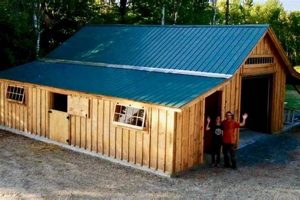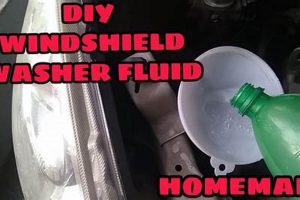Creating vessels for plant cultivation utilizing cement mixtures is a growing trend. These self-constructed horticultural containers offer a personalized approach to gardening, allowing for customization of size, shape, and finish. A common example involves combining cement, sand, and water, then molding the mixture into a desired form, yielding a durable and weather-resistant receptacle for flora.
The rise in popularity of crafting these structures stems from several advantages. The affordability of raw materials makes this a cost-effective alternative to purchasing manufactured pots. Moreover, the process fosters creativity and provides an opportunity to integrate unique design elements into outdoor or indoor spaces. Historically, concrete has been used in construction for its robustness; repurposing it for horticultural purposes extends its utility and aesthetic appeal.
The subsequent sections will delve into specific techniques for constructing plant containers, exploring various mold options, detailing suitable cement mix ratios, and addressing common challenges encountered during the fabrication process. Finishes and decorative techniques applicable to these custom-made garden features will also be examined.
Essential Fabrication Guidance
The following recommendations aim to enhance the durability and aesthetic quality of cement-based plant receptacles crafted independently.
Tip 1: Mold Preparation: Prior to pouring the cement mixture, thoroughly coat the mold’s interior surface with a release agent, such as petroleum jelly or cooking oil. This measure prevents the cement from adhering to the mold, facilitating easier removal upon curing and preserving the mold’s integrity for future use.
Tip 2: Proper Mixing Ratio: Adhere to a consistent cement-to-aggregate ratio, typically around 1 part cement to 2 parts sand to 3 parts gravel, depending on the desired texture and structural integrity. Deviation from recommended proportions can compromise the final product’s strength and longevity.
Tip 3: Gradual Curing Process: After pouring, cover the mold with plastic sheeting to maintain a humid environment. This slows the curing process, preventing rapid water evaporation that can lead to cracking. Mist the surface with water daily for optimal hydration during the initial curing phase.
Tip 4: Reinforcement Considerations: For larger structures, incorporate wire mesh or rebar within the cement mixture to enhance tensile strength. This reinforcement is particularly crucial for preventing structural failure due to soil pressure and plant weight.
Tip 5: Drainage Implementation: Ensure adequate drainage by creating drainage holes in the base of the container prior to the cement fully setting. Proper drainage prevents waterlogging, which can be detrimental to plant health.
Tip 6: Surface Finishing Techniques: After demolding, consider applying a sealant to the surface to minimize water absorption and protect against weathering. Surface treatments, such as staining or painting, can further enhance the aesthetic appeal.
Tip 7: Mold Selection and Design: Opt for molds made from durable materials capable of withstanding the pressure of the cement mixture. Design considerations should include the plant’s mature size and root system to ensure adequate space for growth.
Adherence to these guidelines contributes to the creation of robust, aesthetically pleasing, and functional planting solutions. The meticulous application of these techniques will increase the lifespan of these cement-based horticultural features.
The subsequent section will explore common design choices and finishing methods for further customization.
1. Mold Material Selection
Mold material selection is a critical determinant in the successful fabrication of cement-based plant containers. The choice of material directly influences the resulting shape, surface texture, and ease of demolding. Inadequate mold material selection can lead to structural imperfections, difficulty in releasing the hardened cement, and a diminished aesthetic quality of the final horticultural piece. For example, using a highly porous material without proper sealing may result in cement adhering to the mold’s surface, causing damage during removal and requiring extensive post-processing.
Materials commonly employed for molds include plastic, silicone, wood, and metal. Plastic offers affordability and versatility but may lack the rigidity required for intricate designs. Silicone provides flexibility and allows for the creation of complex shapes with ease of demolding. Wood, while readily available, necessitates sealing to prevent moisture absorption and potential warping. Metal molds offer durability but can be challenging to construct and may require release agents to prevent adhesion. The material selected directly dictates the level of detail achievable, the necessary demolding techniques, and the overall production efficiency of the cement-based planting structure.
Therefore, a thorough understanding of mold material properties is essential to optimize the fabrication process. Evaluating factors such as material flexibility, surface texture, chemical reactivity with cement, and durability is paramount. Addressing these considerations ensures the creation of structurally sound and visually appealing plant containers, minimizing waste and maximizing resource utilization. The informed selection of mold materials, thus, is inextricably linked to the success of independent cement-based planting construction efforts.
2. Cement Mixture Ratio
The cement mixture ratio stands as a foundational element in the fabrication of independent cement-based plant containers. The proportional relationship between cement, aggregate (typically sand and gravel), and water directly dictates the resultant material’s strength, workability, and durability. An improper ratio can manifest in several adverse outcomes, ranging from structural weakness and cracking to poor surface texture and reduced lifespan. For instance, a mixture with excessive water, while enhancing initial workability, compromises the cement’s ultimate compressive strength, rendering the resultant vessel susceptible to fracture under the weight of soil and plants. Conversely, an insufficient water content yields a mixture that is difficult to manipulate and compact, leading to voids and inconsistencies within the concrete structure.
The precise cement mixture ratio is contingent upon the specific application and the desired characteristics of the finished container. A common guideline suggests a ratio of 1 part cement, 2 parts sand, and 3 parts gravel, with water added gradually until the mixture achieves a workable consistency. This ratio provides a balance between strength and ease of handling, suitable for a range of container sizes and designs. However, for smaller, more intricate molds, a highe
r proportion of cement may be warranted to achieve finer surface detail. Furthermore, the addition of admixtures, such as plasticizers, can modify the mixture’s properties, enhancing workability or reducing water demand without compromising strength. Practical application necessitates careful measurement and consistent execution to maintain uniformity throughout the concrete batch.
In conclusion, the cement mixture ratio is not merely a technical detail but rather a critical control parameter in the production of cement-based plant receptacles. Understanding and adhering to appropriate ratios is paramount for ensuring the structural integrity, longevity, and aesthetic appeal of these independent horticultural creations. Challenges in achieving optimal ratios often stem from imprecise measurement techniques and inconsistent mixing procedures. Attention to these details, coupled with a thorough understanding of cement and aggregate properties, is essential for successful creation of durable and functional plant containers.
3. Reinforcement Integration
Reinforcement integration within cement-based plant containers directly impacts their structural integrity and resistance to cracking. Cement, while possessing considerable compressive strength, exhibits limited tensile strength, rendering it vulnerable to forces exerted by soil pressure, root growth, and environmental factors such as freeze-thaw cycles. Incorporating reinforcing materials, like wire mesh or rebar, within the cement matrix mitigates these stresses by distributing them across a wider area, thus preventing crack formation and structural failure. The absence of reinforcement, particularly in larger containers, often results in cracking and eventual disintegration, significantly reducing the container’s lifespan and functionality. A practical example is the use of welded wire mesh in large planters, which resists the outward pressure exerted by the soil as it settles and becomes saturated with water. This illustrates the cause-and-effect relationship: increased reinforcement leads to enhanced structural stability.
The selection of appropriate reinforcement materials and their proper placement within the cement mixture are crucial. Factors to consider include the container’s size, shape, and intended load-bearing capacity. For instance, smaller containers may only require a single layer of wire mesh, while larger, geometrically complex designs necessitate multiple layers or the use of rebar cages for enhanced support. Proper embedment of the reinforcement is also critical; insufficient coverage by the cement mixture compromises its effectiveness. The benefits of integration are numerous as the integration of a reinforcement system contributes to the longevity of the cement-based planting structure, safeguarding it against damage stemming from both internal and external forces. Improper integration results in structural weaknesses that jeopardize the container’s ability to withstand environmental and biological stresses.
Therefore, reinforcement integration constitutes an indispensable component in the creation of durable and long-lasting cement-based plant containers. Overlooking this aspect frequently leads to premature failure and necessitates costly repairs or replacements. While challenges may arise in accurately calculating reinforcement requirements and ensuring proper embedment, the long-term benefits of enhanced structural integrity and extended service life far outweigh these difficulties. Thus, this concept represents a cornerstone in achieving robust and reliable cement-based plant structures.
4. Curing Process Control
The curing process represents a pivotal stage in the creation of durable cement-based plant containers. Curing, in essence, is the hydration process of cement particles, wherein water reacts with cement compounds to form a hardened, solid structure. Proper curing process control is essential to ensure complete hydration, which directly influences the strength, impermeability, and resistance to cracking of the cement matrix. In the context of independent plant container construction, inadequate curing can lead to a diminished structural integrity, rendering the vessel susceptible to damage from soil pressure, plant root expansion, and environmental stressors. For example, cement that dries too rapidly may experience significant cracking due to differential shrinkage stresses, necessitating costly repairs or premature replacement. The impact of curing control cannot be overstated as an improper curing process is the direct cause of weak products.
Effective curing process control typically involves maintaining a humid environment around the cement structure for an extended period. This can be achieved through several methods, including covering the container with plastic sheeting to retain moisture, periodically misting the surface with water, or submerging the container in water for several days. The duration of the curing process is contingent upon factors such as the cement type, ambient temperature, and container size, but generally ranges from 7 to 28 days. Specific techniques can enhance the process. For instance, application of a curing compound forms a moisture-retentive barrier on the cement surface, minimizing water loss. Curing considerations are not simply theoretical since implementing these curing process controls significantly increases the lifespan and performance of the container, safeguarding against material degradation.
In summation, curing process control is not an optional step but rather a mandatory practice in the construction of long-lasting cement-based plant receptacles. Neglecting this phase can compromise the structural integrity and aesthetic appeal of the final product. While challenges may arise in maintaining consistent humidity levels and adhering to optimal curing durations, the investment in proper curing techniques yields substantial dividends in terms of durability and service life. It stands as a cornerstone for achieving structurally sound and resilient planters, aligning with the broader objective of sustainable and functional independent construction.
5. Drainage Implementation
Effective drainage is a critical factor in the design and construction of cement-based plant containers. Proper drainage facilitates the removal of excess water from the soil, preventing waterlogging and promoting healthy root development. The integration of appropriate drainage mechanisms is essential for the long-term viability of plants cultivated within self-constructed concrete planters.
- Drainage Hole Placement and Size
The strategic placement and sizing of drainage holes are paramount. Holes should be positioned at the base of the container to allow gravity-driven water removal. The diameter of the holes must be sufficient to accommodate anticipated water flow rates, typically ranging from 0.5 to 1 inch depending on container size. Inadequate hole size or improper placement will result in water accumulation, leading to root rot and plant death. The number of holes should be proportional to the surface area of the planters base.
- Drainage Layer Composition
A drainage layer consisting of gravel, pebbles, or crus
hed stone should be incorporated at the bottom of the planter, above the drainage holes. This layer prevents soil from clogging the holes, ensuring continuous water outflow. The composition of this layer should be non-degradable and non-toxic to plants. The thickness of the layer varies with container size, generally ranging from 2 to 4 inches. The presence of this layer enhances the effectiveness of the drainage system. - Soil Composition and Water Retention
The choice of soil directly impacts drainage performance. Soil mixtures with high clay content tend to retain excessive water, exacerbating drainage issues. Conversely, sandy soils drain too rapidly, leading to insufficient moisture retention. A balanced soil composition, typically a mixture of loam, sand, and organic matter, optimizes water drainage and retention. The selection of appropriate soil types is critical for maintaining proper soil moisture levels and preventing waterlogging.
- Geotextile Fabric Utilization
A geotextile fabric layer should be positioned between the drainage layer and the soil to prevent soil particles from migrating into the drainage layer, which could impede water flow over time. The fabric must be permeable to water but impermeable to soil particles. This layer effectively separates the soil from the drainage layer, ensuring the long-term functionality of the drainage system and preventing its obstruction.
The integration of these elements ensures effective water removal, mitigating the risk of waterlogging and promoting optimal plant health. Failure to implement adequate drainage measures often leads to plant failure, underscoring the importance of careful planning and execution in crafting cement-based plant containers. Effective drainage significantly extends the lifespan and horticultural effectiveness of independently constructed planters.
Frequently Asked Questions Regarding Cement-Based Plant Container Construction
The following questions address common inquiries concerning the fabrication and use of independently constructed cement-based horticultural vessels. These responses aim to provide clarity and guidance for achieving durable and functional planters.
Question 1: What is the optimal cement mixture ratio for small plant containers?
A mixture consisting of one part cement to two parts fine sand is generally suitable. The addition of water should be gradual, achieving a putty-like consistency. This ratio provides adequate strength for smaller structures while maintaining workability.
Question 2: How can cracking be prevented during the curing process?
Maintaining a humid environment during curing is critical. Covering the freshly poured container with plastic sheeting and misting it regularly with water for several days minimizes water evaporation and prevents rapid shrinkage, thereby reducing the likelihood of cracking.
Question 3: What type of mold release agent is recommended?
Petroleum jelly or vegetable oil can be applied thinly and evenly to the interior surface of the mold. These agents create a barrier between the cement and the mold material, facilitating easier removal upon curing.
Question 4: How should drainage holes be created in cement planters?
Drainage holes can be formed by embedding small tubes or rods into the cement mixture before it sets. Upon hardening, these inserts are removed, leaving adequately sized drainage apertures at the base of the container.
Question 5: Is reinforcement necessary for all cement plant containers?
While not always essential for small containers, reinforcement is strongly recommended for larger structures. The inclusion of wire mesh or rebar significantly increases the container’s tensile strength, preventing cracking and structural failure due to soil pressure and root growth.
Question 6: What type of sealant is appropriate for cement planters?
A concrete sealant designed for exterior use is recommended. Applying a sealant to the finished container minimizes water absorption, protects against weathering, and enhances the container’s lifespan.
These responses provide a foundational understanding of cement-based planting construction. Careful consideration of these elements contributes to the creation of robust and aesthetically pleasing plant receptacles.
The following section will address common design elements for cement plant containers.
Conclusion
This exploration of diy concrete planter construction has underscored the multifaceted nature of this undertaking. From mold selection and mixture ratios to reinforcement strategies and curing processes, each element contributes significantly to the structural integrity and aesthetic appeal of the final product. Effective drainage implementation and consistent adherence to established best practices are also of paramount importance for long-term success.
The information presented herein serves as a resource for achieving durable, functional, and visually pleasing horticultural vessels. Attention to detail throughout the construction process is essential for realizing the full potential of these independent planting features, enhancing both the horticultural and aesthetic value of any environment in which they are utilized. The knowledge provided empowers constructors to create long-lasting structures, minimizing environmental impact and maximizing the potential for sustainable plant cultivation. Thus, diligence and informed execution are critical for successful, long-lasting outcomes.



![DIY Build: Circular Saw Crosscut Jig PDF Plans [Free] The DIY Hub: Creative Crafts, Repairs & Life Hacks DIY Build: Circular Saw Crosscut Jig PDF Plans [Free] | The DIY Hub: Creative Crafts, Repairs & Life Hacks](https://craftingdiycenter.com/wp-content/uploads/2025/07/th-5916-300x200.jpg)


![Diya Aur Baati Hum: Illuminate Your Home [DIY Guide] The DIY Hub: Creative Crafts, Repairs & Life Hacks Diya Aur Baati Hum: Illuminate Your Home [DIY Guide] | The DIY Hub: Creative Crafts, Repairs & Life Hacks](https://craftingdiycenter.com/wp-content/uploads/2025/07/th-5913-300x200.jpg)
